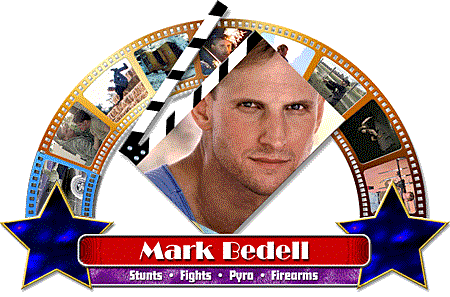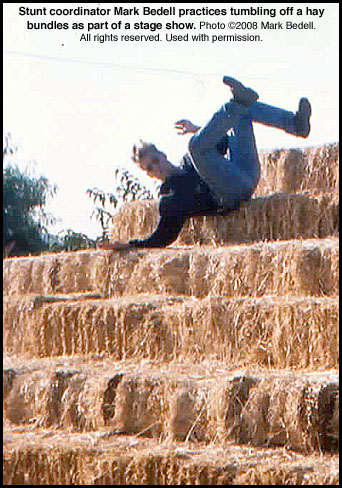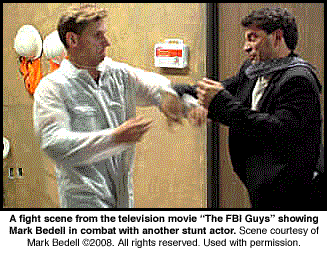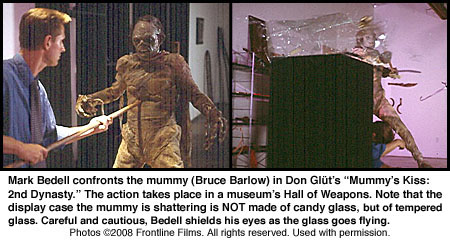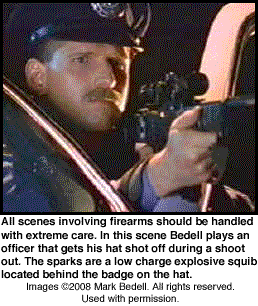Search
Big Budget, Low Budget, or No Budget Movie Productions:
Don’t Take Your Life Into Your Own Hands. Safety First, and Hire Professional Stunt Performers.
Hollywood Stunt Coordinator Mark Bedell
The In-Depth Interview by Robert Long II
PART ONE
Robert: I’m sitting here speaking with Mark Bedell. Now Mark, you really are a “Jack-of-all-trades.” If we were to discuss everything you are capable of doing – it would be a whole book in itself! Now, before we discuss a bit about the pyrotechnics that you have done. Let’s touch base on your stunt work; how long have you been doing this professionally?
Mark: Since around 1982 if you include live stage stunt shows as well as film and television. I did my first screen stunt in 1986 in a television commercial for a car dealership in New Hampshire.
Robert: Now, what were the factors that got you into stunts?
Mark: I had intended for the Military to be my career. I even went to a Military Academy for all four of my high school years. After graduating, I went to join up and after doing well on the ASVABS and passing the physical with flying colors… it was noticed in a medical background check that I had had asthma. That made me 4-F. The military won’t take me. I tried to get a waiver but… they don’t do that. Anyway, I was always into theater, I had done two professional shows and had worked three summers as a performer/make-up artist in a haunted mansion before I even graduated High School. So there I was, my Military career down the tubes before it began and no money for college. I auditioned for a professional theater company and got a lead role… that also happened to have a sword fight. That role got me into another show where I had to do a 16 foot fall, that got into a series of local television commercials, all of which involved some stunt and or fight work. My life sort of unraveled itself from there.
Robert: I would like to touch upon what is referred to as “motivated violence.” Can you give me a description or some examples of what exactly this is, and why it is so important?
Mark: Whether I’m I fight directing for a play, a stunt show, a documentary or a feature; I need to know who the characters are. I need to know if this character knows how to fight and WHY he or she is fighting. Does he/she really want to kill the other person, or is he/she fighting for his (whatever!) life to get out of there? The fight is a story within the story. Along with the actors, I have to create a violent ballet that tells its own story, is true to the bigger story and remains true to the characters within the story. Every move, every turn, every facial expression has to tell us something about what these characters want. That is Motivated Violence.” It is never enough for it to just be a “cool” fight scene, or just violence for violence sake.
Robert: So, what is the difference between dramatic characters fighting and what happens in a real life barroom brawl?
Mark: Okay… this can get confusing and it may seem at times that I’m contradicting myself… but it’s all a matter of degrees. While there are stories, “FIGHT CLUB” for instance, where really realistic fighting is called for. Most of the time you don’t want really realistic… you want believable… big difference. A real fight is messy. People close their eyes, put their heads down and swing wildly. Things happen so fast that you can’t really even tell what’s happening. Watch some “real” fights on You-Tube (make sure they are really real… there are staged fights posing as real fights on You-Tube), or watch a “Tough-Man Competition”. If you want to know what a “real” fight looks like between trained combatants, watch IFL; you’ll more than likely agree… these looks are not good for most stories.
What’s more, the average person has never seen a real fight… all they see is film fighting and to them… that is their reality… now someone comes along and does a really realistic fight scene and the vast majority of the audience thinks, “that fight sucked… they were just swinging wildly and you couldn’t even tell what was happening… It didn’t look real!”
I’ve heard so many (pardon the expression) “film geeks” say, “Chuck Norris fights are so fake!” (as they push their glasses up on their nose)… well, Chuck Norris fights are fake… but he has held an audience and remained among the world’s top action stars for almost 50 years. Filmmakers who tear him down are doing themselves a dis-service. They should try to emulate him.
His fights tell a story, they are clean, dynamic, well shot and appropriately violent. Mr. Norris is also among the nicest guys I’ve even met. I was his body guard for one day at the Cammie Awards in Los Angeles in 2004. I was also privileged to work on a car stunt with Eric Norris on ALIAS. Sorry I got off the track there.
Bottom line is, your fight has to be what the audience expects… and MORE. You’re your fight has to be true to the story. It has to be sharp and segmented enough to be able to tell it’s own story, dynamic enough to WOW your audience but NOT take them out of the bigger story… and of course, it has to be true to the characters… even Villain #2 needs a back story, a motivation and a desire.
Robert: So, would there be a difference between how a policeman fights as opposed to a teenager in a brawl.
Mark: Of course! So when someone asks me to come in the next day and choreograph a fight – but they can’t send me a script – it is going to put me at one hell of a disadvantage! I won’t know what to choreograph. You need to know the landscape. You need to know if you can do any incidental damage – like breaking a desk or chair or lamp. That’s always good to throw into a fight and it really brings up the production value but your Art Dept has to be on board with that decision. When you have two people fight in the desert with nothing else going on – believe me; this has happened to me – it really is a lot less interesting. You writers out there should keep that in mind.
Robert: Mark, how do you go about rehearsing your fights and stunts? How do you do it to where there is a maximum of action and a minimum of danger to the performer?
Mark: My preference is to get at least one rehearsal day for the fight on location with full set. If there are many fights then I would obviously need more than one rehearsal day. I’ll be honest and say that I rarely get that. It’s usually all about working it out on the same day. I hate doing that. It’s never as good a fight scene as it could have been had I had those rehearsal times.
Robert: Do you at least get an hour or a couple hours to do some blocking?
Mark: Usually yes, I have gotten that – but then there are those times that I haven’t gotten it. Honestly the lower the budget the less organized it is and therefore… the less rehearsal time I get. Which is weird because, the indie filmmaker NEEDS good action scenes. They don’t have stars to sell their picture, they need action and/or sex. Well everyone does sex… so much so that you can’t tell indies from soft-core. Set yourself apart! Give your stunt coordinator the time he or she needs to give you extraordinary action scenes. It will make the difference between distribution and total obscurity.
Robert: So even though you are a professional, they are hiring you without the forethought that you are going to need time to study and block the fight out.
Mark: (sighing) Yes… on the high budgets I’m working at 6 to 9 hundred dollars a day… and they give me all the time I need. On the Indies I’m working at $300 a day and they expect me to be Miracle Max! Hey, this stuff takes planning! I’m often dealing with peoples lives in my hands. On high budgets I tell them where to put and how to move the camera and they say “yes sir”! On low budgets I get some 19 year old USC student for a DP who’s arguing with me… taking further time away from getting the shot.
Robert: I’m sure it matters whether you are in an interior versus and exterior…
Mark: That all goes back to motivated violence. A fight in the desert is going to be different; you can pick up sand and throw it at someone. Now in a house there are lamps and letter openers, phones and coat racks. Anything that can be used as a weapon. Again, this depends on the intensity of the fight and the characters. Also, is it a comical fight or a serious fight?
Robert: It sounds like other people may have to be there to help with the stunt. The prop master for example. Some props may need to have doubles of it.
Mark: A lot of productions will have the props guy handle firearms (even if they are firing) frankly, that is precisely why Brandon Lee is dead. If weapons are firing, have an experienced Weapons Master on board, not just experienced in firearms (that’s only one facet of a Firearms Master’s work) he/she must also be experienced in film-firearm safety, etiquette, blanks, squibs, faking a kick, training actors… and so much more.
As for doubles and non-firing weapons, even they (I feel) should be handled by the Firearms Master. One of the main reasons is that whether a gun is rubber, blank-firing, or real, it should be treated the same way and with the same respect. If the cast and crew get desensitized to some yahoo screwing around with a rubber weapon, they will likely not even notice when the same yahoo (or a different one) starts screwing around with a blank-loaded weapon (that’s why John Eric Hexim (sp) is dead).
It can be frustrating when I’m hired for stunts on a film and find props people handling firearms. In the Sci-Fi Channel’s EDEN FORMULA I was a stunt/actor… or action actor as they say. Anyway, there was a line in the script that called for my character to have a Smith and Wesson. The Props girl… we’ll call her, Margaret, hands me this European version of a Walther PPK. I asked her, “Shouldn’t this be a Smith and Wesson?,” She answered “It is!” At that point I had to clue her in that I was also a firearms guy.
“Well, we’ll use this one.” she tells me. Okay… Firearms is not my gig on this one so I have to shut my mouth… but the ting is… this is a real blank-firing weapon. It had to be kicked out of my hands (by Jeff Fahey) on a stairway during a fight.
I asked about a rubber duplicate of this weapon to kick down the stairs. “We don’t have one.” Okay… so… we start the scene using this Walther PPK knock-off, and THEN it gets switched to a polymer (not rubber) Glock – which looks totally different from this Walther. You don’t use polymer for high impact stuff like this or it will break. Every time it hit the stairs paint would fly off of it; it also cracked. I wound up using a rubber Beretta. Bottom line is I ended up with three distinctly different Weapons within the first eight seconds of the scene. Get a REAL Firearms Master!!!
Robert: Well if anybody ever wonders where continuity problems come from, this is a very good example! This also shows that a lot of times it is completely out of the hands of the actor or stunt performer, and careful pre-planning could have helped out greatly in that case.
Mark: Most bad stunts, bad FX and certainly most continuity problems are NOT the fault of the Stunt Coordinator, the Weapons Master, the On-Set Dresser or the Art Department… it is 80% of the time the fault of the Directors (or even more so) the Directors of Photography (DP) who are not listening to the professionals whom they’ve hired to handle these jobs.
To be continued:
For Mark Bedell’s extensive IMDb listing, go HERE.
